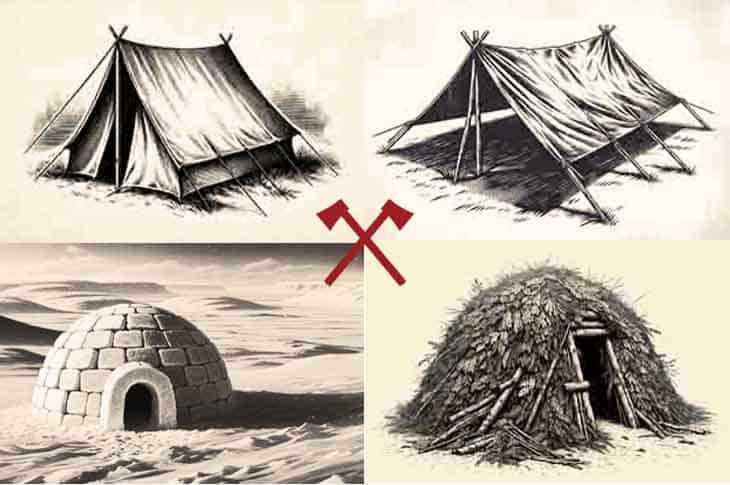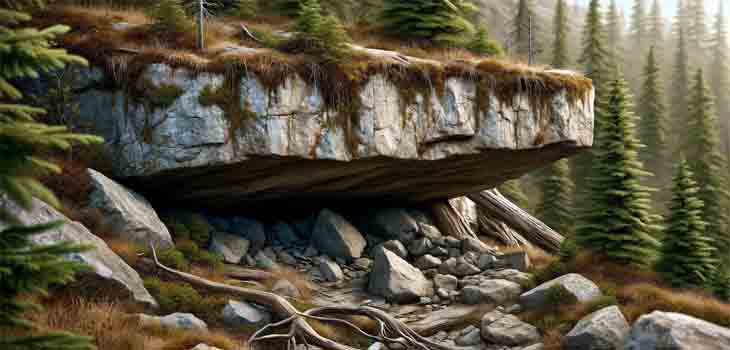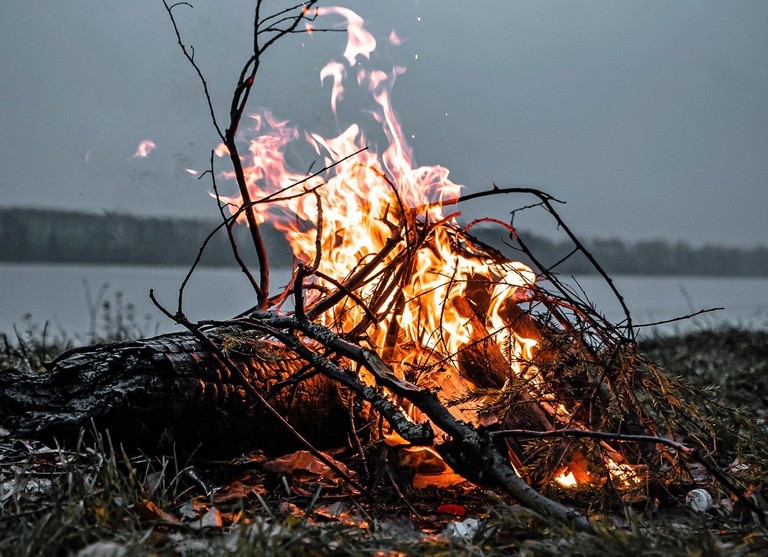Survival Shelters: Your Complete Guide to Wilderness Shelter Building
When you find yourself stranded off the grid after disaster strikes, reliable survival shelters built from the land can be critical to making it out alive. This comprehensive guide covers various emergency shelter options and techniques to create cover and protection in the wilderness.

As a survivalist well-versed in outdoor skills and preparedness, one of the most vital things you’ll need when facing an emergency scenario away from modern infrastructure is securing shelter.
Whether due to natural disaster, technological breakdown, or self-imposed exile to live off the land, mastering fundamental wilderness survival skills for procuring food, water, and shelter is paramount.
Of these survival basics, the ability to rapidly construct durable emergency shelters from available resources separates the well-prepared from the vulnerable.
A properly built shelter in the wilderness provides critical protections that directly impact survivability and resilience. Waterproof overhead coverage shields inhabitants from rainfall, wind chill, and extreme temperature swings through insulation.
Enclosed shelters with fire pits facilitate warming and enable survival in brutally cold environments, while open ventilation prevents toxic carbon monoxide buildup when burning fuel sources inside. The structures can also blend with surroundings to avoid detection and lower the risk of confrontation when civilization breaks down.
This comprehensive guide teaches requisite skills for building survival shelters in various environments using both natural and man-made materials.
Whether you’re an avid hiker, climber, hunter, or ultimate survivalist preparing for offshore existence, these fundamental techniques for erecting practice shelters teach principles applicable across ecosystems and emergency scenarios.
Commit these lessons to instinct and continue honing abilities with repeated drills to prepare for unpredictable catastrophes ahead. Your future may one day depend on these skills.
Key Takeaways from This Survival Shelters Guide
- Prioritize natural formations like dense tree canopies or caves before attempting shelter construction.
- Snow, tarps, debris, tents, and other materials can all be utilized for building survival shelters using fundamental techniques.
- Careful site selection, materials gathering, and sound construction practices are vital to creating functional refuge.
- Master essential designs like lean-to and A-frame architecture as the basis for more advanced wilderness shelter engineering.
- Internalize these lessons with repeated practice to prepare for outdoor emergencies ahead.
| Shelter Type | Pros | Cons | Relative Ease to Build |
|---|---|---|---|
| Cave Shelters | Natural protection, minimal construction | Potential for animal habitation | Very Easy |
| Rock Overhangs | Natural roof, partial enclosure | May need additional construction | Easy |
| Tree Canopies | Natural overhead shelter | Incomplete protection, limited insulation | Easy |
| Tarp Shelters | Versatile, lightweight, quick to set up | Requires materials, can be unstable | Easy |
| Debris Shelter | Good insulation, uses natural materials | Time-consuming, requires effort | Moderate |
| Natural Material Lean-to | Simple design, quick to construct | Limited protection, requires materials | Easy |
| Natural Material A-frame | Stable structure, good protection | More complex design, more materials | Moderate |
| Round Lodge | Sturdy, spacious, good protection | Complex design, many materials | Difficult |
| Ramada | Good for shade, easy to build | Limited protection from elements | Very Easy |
| Quinzhee | Good insulation, protection from wind | Labor-intensive, requires snow | Difficult |
| Snow Cave | Excellent insulation, protection | Risk of collapse, labor-intensive | Difficult |
| Tent | Portable, quick to set up | Requires carrying, limited insulation | Very Easy |
| Bivouac Sack | Extremely portable, quick setup | Very limited space, minimal protection | Very Easy |
| Emergency Blanket | Lightweight, reflects body heat | Minimal protection, single-use | Very Easy |
| Sleeping Bag | Portable, warm | Requires carrying, ground insulation | Very Easy |
| Hammock | Off-ground sleeping, portable | Requires trees, limited insulation | Easy |
This table offers a focused comparison based on the relative ease of building each type of shelter, considering the general characteristics and requirements of each.
Table of Contents
Types of Wilderness Survival Shelters
Those new to outdoor survival often underestimate the diversity of refuge options available derived straight from the land.
The first course of action before expending effort on constructing your own shelter is identifying and improving naturally occurring shelters already present.
Failing that, techniques utilizing available resources in the environment including debris, snow, and synthetic materials provide limitless possibilities constrained only by your capabilities and imagination.
Natural Formations for Wilderness Survival Shelters
In line with survival techniques centered on working with nature as opposed to combating it, begin your search for shelter by surveying the landscape for advantageous natural formations.
Cave Shelters
Underground cave shelters present optimal enclosed shelters, providing natural windbreaks and insulation against harsh external elements.
Take care to thoroughly inspect such formations before going inside, ensuring structural stability and absence of previous or current inhabitants like bears that may take issue with your presence.
Cave and crevice-dwelling bats also pose disease transmission threats if their roost is disturbed. Provided you find a secure uninhabited cave with solid supports, few shelter types can match the protective properties and temperature regulation cave systems provide once outfitted with basic living essentials.
Pros: Complete weatherproof enclosure, temperature insulation, concealed shelter
Cons: Limited airflow, inability to have open flames

Rock Overhangs
Rocky outcroppings with overhanging ledges generate covered spaces shielded from the brunt of weather elements.
While they lack the complete encapsulation of caves, the coverage of rock overhangs combined with the supportive foundation for adding frameworks makes for an excellent shelter site.
Erect walls and insulation underneath overhangs using survival techniques for transforming natural formations into optimized refuge.
Pros: Covered space protected from rain and wind, supports additional construction
Cons: Minimal padding from hard ground, limited temperature insulation
Tree Canopies
The upper layers and interconnected branches of forest canopies provide reliable overhead shelter from sun exposure, rainfall, and—depending on density—wind chill.
Bring rope and learn essential noose knots to safely hoist and secure your own suspended shelters up amongst the boughs using bushcraft tools.
Inventive survivors can transform small forest groves into elevated habitat with interconnected suspended platforms, allowing group clustering within the protected spaces beneath dense upper canopies the trees provide.
Pros: Available shade/coverage, airflow from heights
Cons: Limited insulation without walls and floor
Man-Made Survival Shelter Designs
Those well-versed in fundamentals of shelter building can construct impressive dwellings rivaling refined houses using stone tools and wilderness resources alone.
But rudimentary shelters made from collected debris and materials in the local habitat don’t require master craftsmanship to be impressively effective.
Learn techniques for improvising essential structures capable of keeping you alive through the worst of storms.

Tarp Shelters
Packing durable tarps provides survivors with waterproof roofing and wall materials useful for improvising an array of effective enclosure designs:
A-Frame – Simple sloped style utilizing hiking poles/sticks and overhead ridgeline for rain gutter runoff
Lean-To – Single pitched roof build against natural structure like trees or rock wall
Pros: Lightweight/packable, hoist off ground, versatile configurations
Cons: High winds can shred tarps, need additional insulation layers

Debris Hut Shelters
One of the most useful bushcraft shelter designs involves mounding and layering accumulated debris from the surrounding environment to create an insulated refuge. Like the tarp shelters above, except replacing the tarp with natural materials.
Standard designs include:
Lean-To – Support log frame clad in layered debris
A-Frame – Same concept as tarp A-frame using stacked debris as roof
Pros: Well insulated from dead plant matter, camouflaged
Cons: Lots of materials required, rain slowly penetrates

Snow Shelters
In survival situations involving heavy snowfall, understanding principles of shelter building in winter conditions is critical.
Snow itself provides excellent thermal insulation when properly packed and offers multiple dwelling approaches:
Igloo – Dome structure of stacked snow blocks
Quinzhee – Burial cave hollowed from beneath a layered debris and snow mound
Snow Cave – Horizontal tunnel dug straight into a consolidated hillside snow drift
Pros: Excellent insulation value, blocks wind
Cons: Significant snowfall vital for construction
Other ManMade Shelter Designs
Many other imaginative shelter frameworks exist beyond the staples already outlined:
Round Lodge – Free-standing circular dome structure of interwoven whole saplings and insulated mat wall coverings
Ramada – Basic rectangular open front wooden frame with canopy roof, best in hot dry climates
Pros: Adaptable size based on material lengths, rain shedding lodge shelters
Cons: Significant time/materials required to construct properly
Portable Shelter Solutions
Even lacking built shelters from collected origin materials, those equipped with specific survival gear like tents and bivouac sacks can rapidly transform carry capacity into livable dwellings.
But packing weight severely limits capacity for redundancy, making knowledge of improvised shelters invaluable if equipment fails.

Tents and Bivouac Sacks
Inflatable tents and waterproof bivy sacks provide lightweight and packable enclosed shelter options:
Bivouac Sack – Breathable waterproof fabric cocoons to insert sleeping bag and shelter occupant
Tent – Freestanding dome structures with floors offer interior living space safe from elements
Pros: Lightweight, extremely packable, rapid setup
Cons: Vulnerable material easily torn without repair, limited insulation against ground
Emergency Blankets and Sleeping Bags
Don’t underestimate the importance of emergency blankets and well-insulated sleeping bags—they could save your life.
Emergency Blankets – Retain body heat by wrapping reflective mylar coating around you
Sleeping Bags – Insulated bags protect from cold ground, retain warmth
Pros: Extremely packable, vital for preventing hypothermia
Cons: Require additional overhead shelter, still lose significant body heat into ground

Hammocks and Suspended Shelters
Get off wet ground by suspending from anchor points like trees using rope and hammocks or rigging enclosed tents underneath:
Hammocks – Lightweight woven sleeping pods hung between trees
Suspended Tarps – Waterproof roof overhead with partial walls around edges
Pros: Ventilation comfort, avoid cold/wet ground
Cons: Exposed without rain fly or fully enclosed tent
Fundamentals for Wilderness Shelter Building
Beyond selecting a design, proper site analysis and sound construction practices make the difference in refuge effectiveness.
Consider key variables in your environment to determine optimal positioning.
Shelter Design Principles
Keep these factors in mind when planning and selecting shelter locations:
Wind Dynamics – Locate natural windbreaks like rock walls or dense tree stands. Face broad opening southwards in northern latitudes to utilize sunny exposure.
Weather Impact Mitigation – Position shelters on slightly sloped ground for drainage. Surround with diversion trenches to avoid flooding. Site under natural overhangs that facilitate rain runoff and reduce exposure.
Thermal Regulation – Insulate floors and walls to isolate from conductive heat loss into ground and atmosphere. Site shelters with sunny exposure and thermal mass like rocky outcroppings to allow solar heat absorption.
Ventilation – Confined spaces grow toxic without fresh airflow. Ensure gas exchange by venting structures at top while preventing wind tunnel effect.
Stealthiness – Use camouflage and natural noise dampening when concealment from other people is paramount in shelter siting decisions.
Visibility – Alternatively, construct bold visible markers for friendly searchers if rescue depends on detection from air or distances.
Proximity to Resources – Ensure site allows hidden access to fresh water, shelter construction materials, hunting grounds, foraging zones, and fuel for fires.
Specific Build Techniques and Guidebooks
With a grasp on fundamentals of sound design and site analysis for wilderness refuge construction covered, here are step-by-step guides for executing two classic staple shelters used across environments and scenarios:
A-Frame Shelters
A-frame buildings provide reliable protection across nearly all wooded environments. Arrange as open-faced or fully enclosed:
1) Select two anchor trees appropriately spaced, run taut ridgeline rope between.
2) Extend diagonal legs down from ridgeline ends, secure with L-joints at base to frame A-shape.
3) Drape waterproof tarp/plastic sheeting over A-frame. Angle sides to shed rainfall off back.
4) Weigh down edges or use surface screws to tension tarp skin.
5) Insulate underneath or use debris to clad the exterior while allowing ventilation.
Pros: Fast deployment, adaptable size, weatherproof peaked roof
Cons: Limited insulation without debris packing around structure
Lean-To Shelters
The lean-to presents a classic staple design offering good protection from elements with low complexity:
1) Position broad opening facing south or away from wind. Anchor horizontal support beam between two tree trunks at 4-5 feet above ground.
2) Slope additional beams down from side anchors at roughly 45 degree angles to create slanted roofline.
3) Interlace supportive lattice layer across purlins with branches, saplings, or debris.
4) Top lattice with waterproof outer layer using tarps, bark sheets, or debris mats.
5) Insulate inner floor and walls by piling in debris, leaves, grass layers to trap air and block wind.
Pros: Effective windbreak design, insulated interior
Cons: Significant materials required, vulnerability in high winds
Bushcraft and Survival Shelters
Mastering the art of wilderness survival means learning how to build a solid shelter using minimal tools and what nature provides.
Bushcraft teaches self-reliant skills for thriving beyond society’s comforts. Whether facing disasters or seasonal shifts during extended camping, shelters are a crucial part of bushcrafting.
We all have inner scouts who can fashion functional refuge from sticks and stones when needed. Understanding the land and climate helps us decide on the ideal site.
Choose high ground, gauge wind patterns, find natural fortifications. Mother Nature supplies the building blocks, we stack and build them into safe places.
Here we’ll share pragmatic shelter wisdom – proper site selection, weatherproofing, meeting priorities, improving amenities.
The basics remain unchanged – tools, materials, needs. Apply bushcraft fundamentals and both short-term crisis shelters and longer-term encampments are possible.
Tools for Making Bushcraft and Survival Shelters
Having the right tools available can make building a survival shelter much easier. Essential items like axes, knives, and paracord are extremely useful for constructing an emergency shelter.
Axe: An axe allows you to fell small trees and cut branches and logs to size in order to assemble the frame and structure of your shelter.
Saw: A good alternative to an axe is a reliable folding saw. Axes can be heavy whereas the best bushcraft saws tend to be much lighter, more compact, and easier to carry in a pack.
Knife: A sturdy fixed-blade knife gives you precision cutting ability to sharpen branches or cut notch joints for binding shelter components together.
Paracord: Paracord is indispensable – its high strength and versatility means you can use it to lash shelter components together or create guy lines to brace frameworks against wind loads.
It’s important to understand correct and safe usage of these vital wilderness tools. Misusing an axe can result in serious injury.
Take your time and don’t overexert yourself. Maintaining control of the blade at all times is crucial. Let the weight of the axe head do most of the work rather than swinging wildly. Choke up on the handle for more precision cuts. Keep your cutting area clear of obstacles and be aware of footing.
When using a knife, always cut away from your body, taking care to not let the blade close on your fingers. Keep knives razor sharp via frequent sharpening to prevent dangerous slips.
Wear gloves when manipulating rope and cordage to avoid rope burns or cuts.
Making Use of Your Surroundings
Choosing just the right location is one of the most important decisions when building a survival shelter.
Consider the elevation, slope, and drainage of an area. Higher ground is often better in case of flooding, while a slope can provide drainage.
Make sure large branches overhead don’t pose a threat in high winds. Finding a site near materials you can use for constructing the shelter will save time and effort gathering supplies.
Take note what side the prevailing winds come from and orient the shelter entrance away from wind and storms.
Utilizing available materials like downed logs, tree branches, leaves, grasses can reduce the amount of construction from scratch. Carefully assess any natural shelters like rock overhangs, caves or hollow logs for suitability before opting to build from scratch.
Assessing wind direction allows you to reinforce the windward wall for increased protection. Natural features like rock overhangs, caves, or thick stands of trees can provide inherent shelter to adapt to your needs with minimal additional construction.
Foraged building supplies mean less tools and effort expended creating shelter components. Gather fallen dead wood rather than cutting live timber whenever possible.
Seek out the driest, most rot-resistant wood for structural members to prevent collapse.
Stockpile more wood than you think you’ll need in case unexpected weather prohibits further foraging.
Move wood and debris under tarps or plastic sheeting if rain threatens to soak materials before construction is complete.
Considering Your Needs
There are many types of survival shelters to consider including natural shelters, lean-tos, debris huts, tree pit shelters, snow shelters, tarp tents and more.
The needs of your situation will dictate what kind of shelter to build. Solo travelers have different priorities than a family with small children or elderly members.
Someone with injuries may require room for splinting broken bones while healthy group members construct the main shelter framework.
Short term shelters built during fair weather may focus less on insulation and more on keeping rain or groundwater out until rescue arrives.
Long term shelters intended for extended wilderness occupancy require more robust construction to protect inhabitants from prolonged exposure to cold, wind, snow, storms or heat depending on local climate.
Design considerations are also driven by availability of natural materials on hand. For example conifer forests make pine boughs and thick moss ideal for insulation which may not exist in hardwood forests.
Desert survivors would utilize cactus ribs or brush while cave explorers might use loose stones for building materials.
Here are some examples:
- A lean-to made from fallen logs and pine boughs works well for short term survival needs in conifer forest environments.
- A debris hut made from sticks, leaves, grass and dirt can be quickly assembled in wooded areas and provides good insulation.
- Snow shelters like quinzhees or snow caves are necessary when winter conditions prevail. Excavate down below the frost line for natural surrounding insulation.
- Tarp tents are an excellent choice when minimal equipment is available. They provide weather protection and warmth when combined with loose debris insulation underneath.
Improving Bushcraft Shelters
While a basic survival shelter provides crucial protection, additional improvements can make longer term shelters more comfortable.
- A raised sleeping platform lined with pine boughs lifts you off cold ground which conducts heat rapidly.
- Stack loose rock or stone which absorbs warmth from fires and releases it slowly overnight when temperatures plunge.
- Fire itself both reflects heat but also provides psychological comfort from light.
- Build a small fire reflector from logs at the shelter entrance which projects warmth indoors without compromising safety.
- Stoke fires before bed to fully heat shelter rock and masonry which radiates soothing warmth until daybreak.
Shelter Site Selection and Considerations
Choosing the Right Site for Your Survival Shelter
Selecting the optimal site involves several considerations. Stay reasonably close to water and food sources but not too close to attract predators like bears.
Flat or gently sloping terrain is best.
Check for signs of dangerous wildlife in the area before settling on a location.
Ensure the site has suitable drainage via sloping ground or absorbent soil to prevent flooding during storms.
Shelter orientation matters as well.
Face the back of the shelter (where you sleep) away from the prevailing wind direction.
Utilize natural windbreaks like hillsides or stands of trees to provide protection. In cold climates, an eastern exposure lets morning sun warm the interior while blocking blistering afternoon summer sun.
A southern exposure receives more sunlight overall. Northern exposures open to biting winds decrease shelter temperature drastically.
Weatherproofing and Insulation
Weatherproofing is crucial to shelter comfort and safety. Use loosely stacked dead vegetation like grass, leaves, moss and rotten logs for insulation which traps pockets of air to prevent conductive heat loss.
Avoid matting down insulation over time which eliminates this vital air space. Shake out and fluff up debris routinely.
In extreme weather conditions redundancy in vital protective systems is key.
Build double layered walls with dense insulation material like leaves or grass contained loosely between them.
The middle air space prevents convection cooling while containing insulating materials against the inner wall where it’s most effective.
A dedicated wind break wall in front of main walls blocks wind before it penetrates inner layers.
A vestibule airlock entryway prevents direct wind and water ingress each time inhabitants enter or leave the main structure. Its second door allows you to seal the main door before opening the outer one.
Ventilation removes oppressive humidity which can lead to dangerous hypothermia.
Create small vent holes at peak areas to let warm air naturally rise and escape as water vapor without allowing rain inside.
Use long hollow tube chimneys to vent fireplace smoke outside without heat or spark escapes.
Shelter Strength and Structural Integrity
A sturdy survival shelter is vital to prevent collapse from wind, snow load, storms or falling debris.
Choose young green timber for framework whenever possible rather than old brittle branches.
Green wood is flexible, less likely to snap unexpectedly under strain. Old wood grows more slowly making it stronger but often heavier which increases collapse hazards.
Lash supports and cross members with paracord or stripped bark cordage.
Wrap lashings in figure eights not simple crosses to distribute loads multi-directionally.
Bury corner posts and central roof pillars deep in the ground or mound heavy stones around their bases for added anchors against gale forces.
Build framework structural walls first, followed by outer rain shield walls, then inner insulating cavity walls last to allow continual monitoring of skeletal integrity without subsequent layers obscuring potential issues as construction progresses.
Dig drainage trenches around the full shelter perimeter to channel flood waters away.
Shore up walls with stone or log bracing outside for stability. Build doorways narrow but tall enough to allow entry without undue ducking or scraping which can weaken frame timber.
Construct storage vestibules for protecting main doors as previously described.
Safety is also a concern when securing your survival. Avoid sites directly below dangerous widow-makers – precarious dead trees or branches which may crash down without warning.
Check for overhead dangers like deadfall traps or snow loaded boughs directly above you before building fires or sleeping areas.
Keep fire reflectors a safe distance from walls and roofing. Ensure stovepipe chimneys have spark arrestors before venting interior blazes outside.

FAQs About Survival Shelters
What kind of shelter is best to stay safe in?
In general, fully enclosed shelters like debris huts, snow shelters, or small timber built structures protect occupants best from all outdoor hazards.
Their insulated walls and roof trap radiant body heat while preventing wind, rain and frigid air penetration inside. Smaller shelters require less wood or other materials to create but make for packing multiple inhabitants uncomfortably tight.
Larger enclosed shelters with built in insulation take more effort to construct initially but pay off with increased safety, survivability and comfort over the long term versus open lean-tos which still leaves you partially exposed.
Well designed enclosures consider simple yet vital functions like chimneys for ventilation and sealing vestibules for storing firewood or gear indoors where it’s protected from elements.
What’s the simplest kind of shelter you can make?
The easiest quick survival shelters require minimal tools, effort or construction materials.
For example, a simple three-sided debris lean-to made from sticks or cut saplings and packed with leaves against a fallen log takes little time to provide basic wind and water protection.
Bending pliable green saplings over and anchoring both ends with rope or paracord to form single or double layered teepees draped with emergency tarps creates effective short term enclosures.
Existing hollow fallen logs can be partially excavated then plugged on the open end with mud, leaves and debris to create instant refuge, safe from all but the largest predators.
While such rudimentary shelters take minutes to erect, their minimalist open frameworks or semi-enclosed shapes afford far less insulation, structural longevity and overall protective qualities compared to more deliberate permanent buildings.
But in a pinch they beat lying exposed to the raw elements while awaiting rescue or better weather to construct sturdier shelters.
What are three different kinds of shelters?
- Debris huts are highly insulated fully enclosed shelters built from vehicle natural materials like sticks, leaves, dry grasses and dirt piled tightly over frame walls. Tiny entranceways seal in radiant heat from small interior fires while shedding wind driven precipitation outside.
- Quinzhee snow shelters take advantage of readily available frozen water. Piles of hard packed snow several feet deep is heaped over sapling rib frames. Once the mound hardens completely, builders tunnel inside, evacuating excess snow to sculpt living chambers whose dense icy walls provide excellent insulation against frigid outside air.
- Tarp tents are versatile ultralight shelters for minimalist wilderness trekkers. Built by strategically draping tarps and plastic sheeting over rope guy lines tied between trees, suspension points or an underlying stick framework, they allow quick assembly from limited equipment. Combined with natural loose debris insulation piled underneath, tarp tents create weatherproof enclosures adaptable across multiple terrain types and climates.
How do you find a place to stay safe in an emergency?
- Survey surroundings for natural shelters like rock overhangs, caves or hollow fallen logs that require minimal modification to create habitable refuge. Seek out existing structures to adapt rather than build from scratch.
- Assess areas with resources to construct shelters from the ground up if existing options prove unsuitable. Identify dead standing timber for structural members, flexible green saplings for lashings. Gather debris for insulation like dead pine needles, leaf litter or grass tufts. Proximity to food/water sources is ideal as well.
- Determine prevailing wind direction, seasonal rain and snow averages. Identify hillsides or stands of trees to provide windbreaks. Locate flat or gently sloping terrain at higher elevations, safe from flooding with proper drainage.
- Clear overhead hazards like snow loaded boughs or dangerous hanging branches that may break free under strain before building your chosen site.
- Orient shelter openings away from usual incoming wind or storms for increased safety and comfort. Fortify the shelter’s windward wall and build storage vestibules to prevent wind and moisture entering the main structure.
How do you keep a shelter warm?
- Insulate shelter walls and roof with substantial stacked debris like grass, leaves, ferns or bark which traps air and body heat. Avoid matting materials down or compacting insulation which eliminates vital air pockets that prevent conductive heat loss to cold surroundings.
- Build small fire pits or fireplaces as primary heat sources. Line enclosures with clay or stone to prevent accidental structural fires. Ventilate smoke safely through flues outside living areas using chimney tubes. Site fire rings centrally to radiate warmth in all directions throughout interior spaces.
- Gather surplus kindling under cover so it stays dry and ready to fuel fires using proper fire lays. Even brief rainfall can saturate available timber, rendering it temporarily unusable for ignition until it thoroughly dries out again. You want wood fuel reserves unaffected by unexpected showers or storms.
- Layer waterproof outer tarps over frame walls, then pack in substantial middle insulation like debris or even snow before adding inside secondary walls. This layers exterior water protection outside of inner insulators, sandwiching fill between to prevent convection heat losses.
Final Words
When crisis arises in the wilderness, creating shelter from the elements often means the difference between survival and tragedy.
No singular blueprint guarantees success when designing refuge, but certain fundamentals underpin construction of reliable shelters using minimal tools and foraged materials at hand.
Insulation, structural integrity and weatherproofing define robust dwellings that protect inhabitants through harsh conditions or prolonged stranded scenarios until rescue reconnects them with civilization.
Survival wisdom passed down over millennia live on through your outdoor skills like building durable wilderness shelters able to sustain and shield you from harm using little more than wits, hard work and perseverance.










